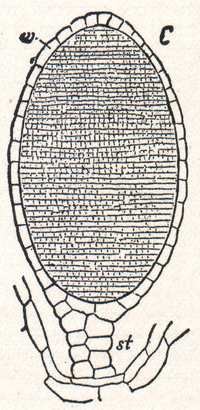tail spread out to protect it from sun and rain. In defending itself, it makes good use of its strong forearms.
An'telope, an animal like the deer, belonging to a group between cattle and goats. Its horns are ringed and hollow and are not renewed annually. The size varies greatly, the pygmy antelopes of South Africa being only from eight to nine inches in height, while the largest kinds are from five to six feet. Antelopes are found in Europe, Asia, Africa and America. They are the fleetest as well as the most beautiful and graceful of quadrupeds. Two kinds are peculiar to North America—the Rocky Mountain goat, which is a true antelope, and the prong-horn. The latter stands apart from the true antelopes, from the circumstance that annually it sheds the outer sheath of its horns. There is an interior bony; core that remains permanent. These animals are distributed from the Missouri River to the Pacific and from 53° N. latitude southward into Mexico. At one time there were immense herds in the San Joaquin Valley in California. They are now abundant in northwestern Mexico. The common antelope is found in India and Eastern Asia. It is about two and a half feet high at the shoulders, with erect diverging horns bent in a spiral form. It is so swift that gray-hounds cannot catch it, and it leaps easily a height of ten or twelve feet, while the length of its bound is often ten or twelve yards. The Chinese antelope is found in the deserts of Central Asia. Its flesh is very much prized. The gazelle of North Africa was known to the ancients, its beautiful black eyes being often spoken of by Arabian poets. In the Alps we find the chamois and in South Africa the eland, the largest of all the antelopes.
Anther (dn'ther). That part of a stamen which produces the pollen. See Flower.
Antneridium (anther-Wi-tim). The male organ of plants. Within it are produced the sperms or their equivalents, which fertilize the female cells or eggs. The antheridium varies in structure in different groups of plants, being for the most part a single cell in the Thallo-phytes, and a several to many-celled structure in the higher groups. It is important to note that the antheridium holds no relation to the anther, the structure in the flower which produces goUen, for the anther is not a male organ. To avoid this confusion it has been proposed to change the name antheridium to spermary.
Antherozoid (an'ther-d-zd'U). A name often applied to the swimming o r motile sperm of plants. See SPERM.
Anthoceros. A genus of the plants known as liverworts which gives name to the group An-thocer ot ale s. The group contains but few forms, but is of great interest from the fact that from it the mosses seem to have developed, and possibly the ferns and seed-plants also. The body (gametophyte) is a simple flat thallus, and produces a slender spore-case (sporophyte) which is remarkable for its continued growth in length and its green color. See Hepatic.
Anthony, Henry Bowen, American statesman, was born at Coventry, R. I., April i, 1815, and died at Providence, R. I., September 2, 1884. Graduating at Brown University, he took early to journalism, and was for a time editor of the Providence Journal. In 1849-50 he was governor of Rhode Island, and, nine years later, he entered the United States senate, and was a member of that body until his death, serving frequently on important committees, and acting on several occasions as temporary president of the chamber.
Anthony, Susan Brownell. In 1854 a school teacher appeared in Albany, New York, to present a petition signed by 28,000 persons for better laws to regulate the liquor traffic. A member of the As-s e m b 1 y said: "Who are all these signers— nobody but women." Nobody but women—mothers, wives, daughters, sisters who wanted to protect their protectors against evil habits that threatened the home. The teacher, as she turned away, said: "A woman's name on a petition will never be as good as a man's until she has a vote." Susan B. Anthony from that day was an equal suffragist. That thought was her whole creed, precept and practice. For



